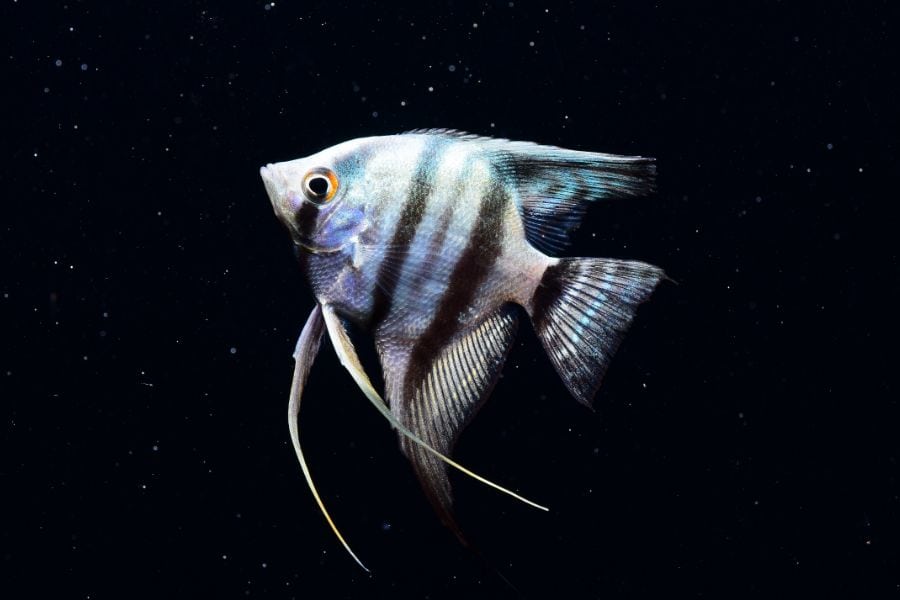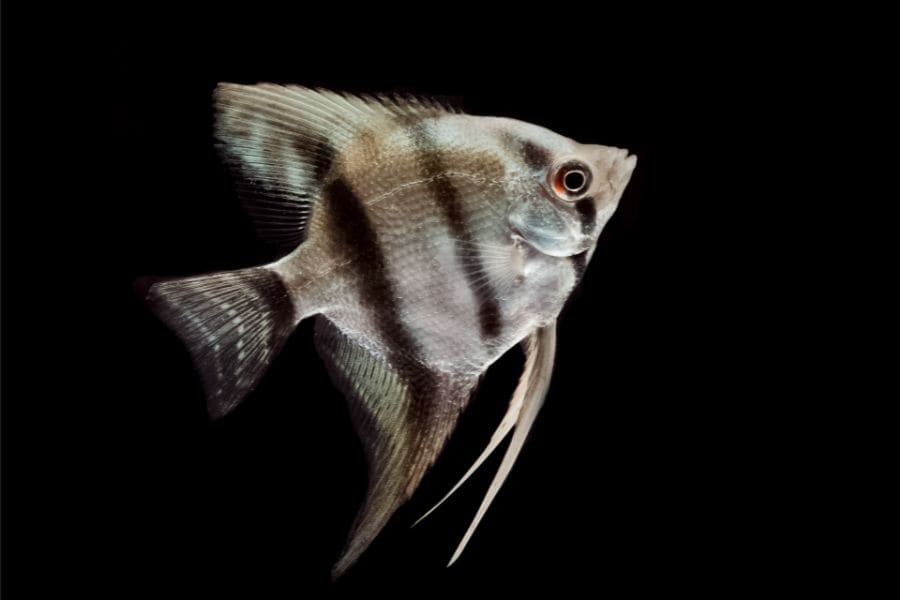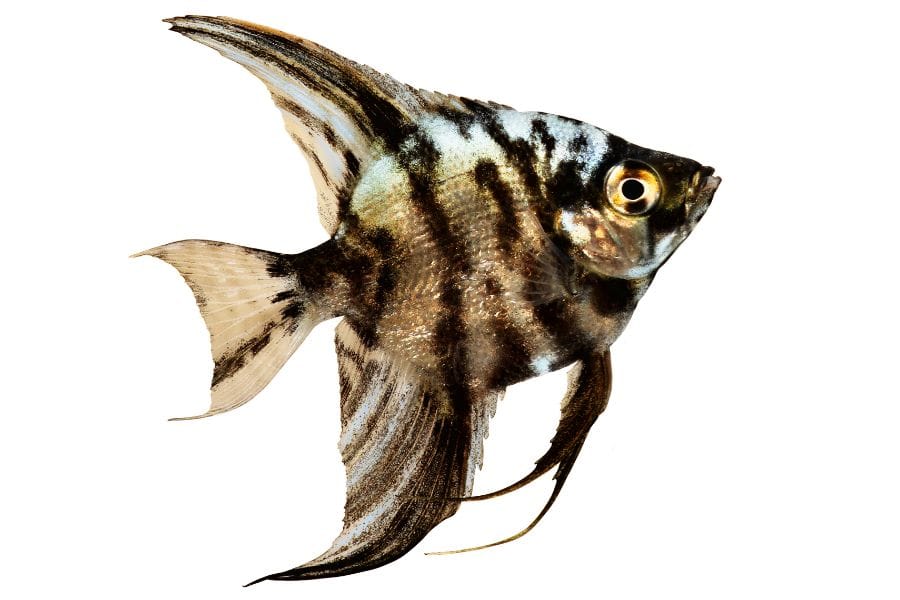The angelfish is one of the iconic fish species that most people know on sight. Their flowing fins, eye-catching shapes, and fascinating grace when swimming never fail to draw one’s eye.
More than that, they’re also relatively hardy and easy to care for. You’ll have no problems keeping angelfish in your home aquarium as long as you know their basic care requirements.
In this article, we’ll tell you everything you need to know about keeping a beautiful, thriving tank of magnificent angelfish.
So, if you want to have a thriving tank of magnificent angelfish, you must keep reading below.
Angelfish Species Basics
Before we get into the basics of angelfish care, you first need to know what kind of angelfish you have in the first place.
There are three main angelfish species, and the specific one you have can affect the care requirements and even breeding strategy should you go down that route.
Here are the three angelfish species:
- Pterophyllum Scalare (Common Angelfish): Common angelfish are known for their elegant, triangular bodies with elongated dorsal and anal fins. They display striking colors and patterns and often feature vertical stripes.
- Pterophyllum Altum (Altum Angelfish): Altum angelfish are noticeably taller and more slender than other species. They have a distinct look with a sloping forehead and long, graceful fins.
- Pterophyllum Leopoldi (Leopold’s Angelfish): Leopold’s angelfish is the smallest of the angelfish species, with a rounder body shape and characterized by a distinctive, bold black-and-white coloration pattern.
It’s also important to note that the varieties that will be discussed below can occur in just about any of the species. Most angelfish colors and characteristics are not unique to one species.
For example, there are platinum scalare angelfish as well as platinum altum angelfish. They’re still different angelfish species; it just so happens that they have the same color or pattern variation.
This makes for a great mix-and-match of aesthetic qualities that makes keeping angelfish particularly fun compared to other fishes.
16 Angelfish Types for Freshwater Aquariums
Now that you know the main angelfish species, here are 16 different types of angelfish that you can keep in your freshwater aquarium at home.
1. Silver Angelfish
With their silver bodies and three distinctive bands, the silver angelfish possess an elegance that’ll never go out of style.
These angelfish possess sleek, metallic silver bodies that shimmer gracefully in the water, complemented by flowing fins and three distinct vertical black stripes running through their bodies.
These black stripes are what distinguishes them from the other species. Having no black lines means they’re a different variant called platinum while having more than three brands as a zebra variant.
Silver angelfish is the most common variety and resembles the original wild-caught angelfish. They’re hardier than other angelfish types because they’ve been bred for tank conditions for several generations, which means they’re great for beginners.
2. Marble Angelfish
Another very popular strain of angelfish is the marble variety, characterized by the spectacle of color in their bodies.
The marble angelfish is the most diverse of the other varieties, as there are seven more varieties of marble coloration. This variant can occur in any base color and contain different spots or speckles.
The koi angelfish is actually a marble type of angelfish. Variations also include silver, black, blue, orange, and pearl scale types.
These angelfish are highly sought after for their striking appearance and relatively low care requirements.
3. Koi Angelfish
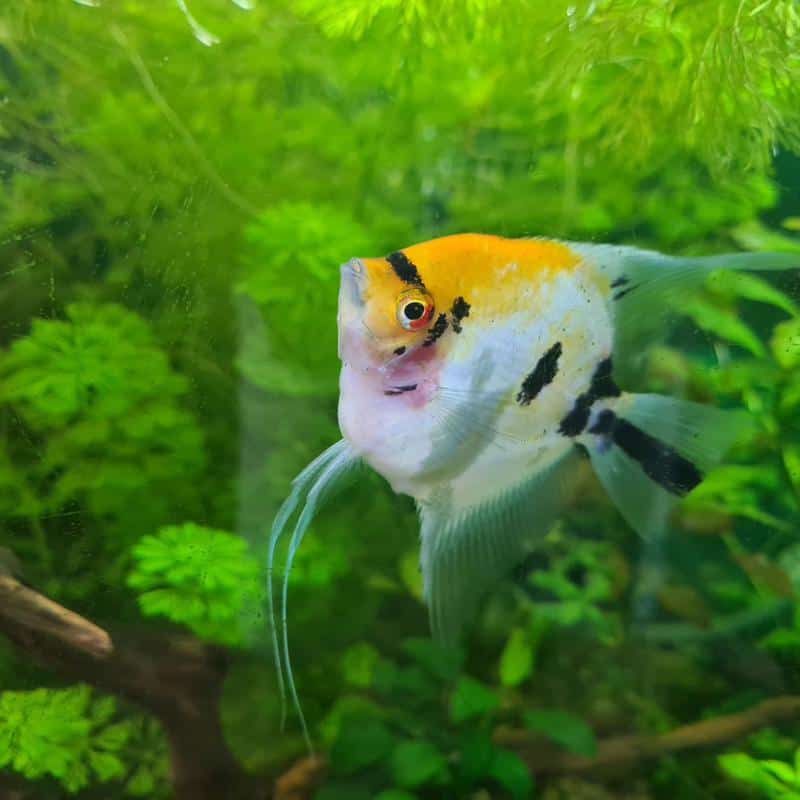
Koi angelfish are a captivating variation known for their striking resemblance to the popular pond fish, the koi.
Featuring a stunning blend of orange, red, black, and white colors, each koi angelfish has a unique blend of colors that creates a mesmerizing mosaic in their bodies. Keeping a school of koi angelfish will surely delight the eye.
Care for koi angelfish is similar to common angelfish, requiring stable water conditions and a spacious tank with ample swimming room to showcase their beauty.
4. Veil Angelfish
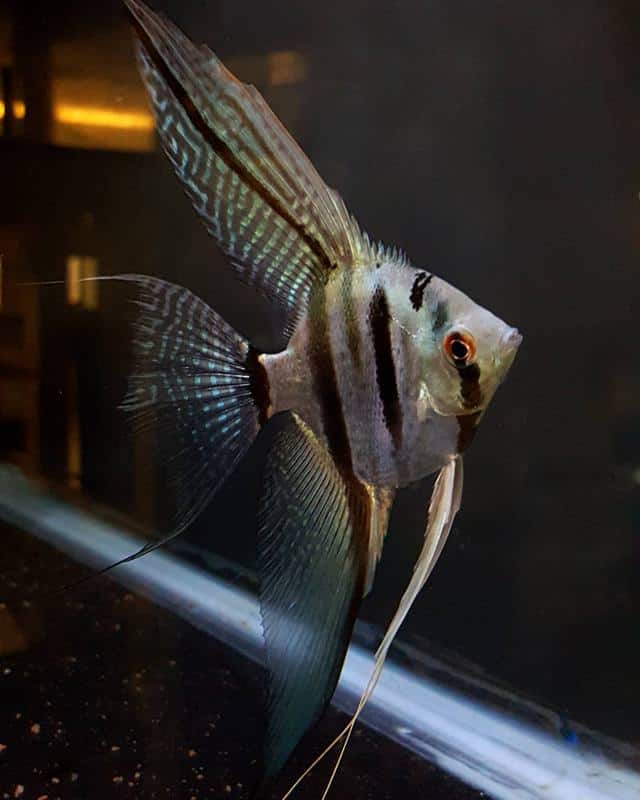
Where the previous varieties were all about colors, the veil angelfish variety sports unique physical features that truly set them apart.
They’re famous for their elegant and almost regal demeanor, often seen as the royalty of the angelfish world.
This is due to their long, flowing fins that gracefully trail behind them as they swim. These fins add a particular drama to their swimming, making them particularly attractive to see in long, spacious tanks.
That said, they do have unique care requirements. For one, you need to get them deeper and longer tanks, as their fins can grow quite long. They need this wider area to comfortably move around.
5. Black Raven Angelfish
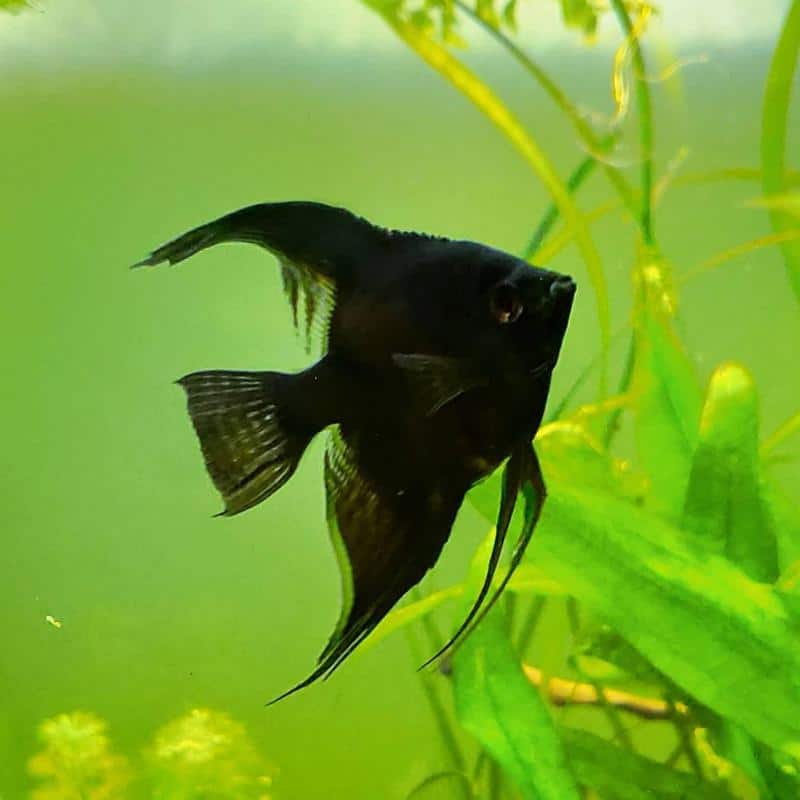
Black raven angelfish are a striking and unique variety known for their deep, jet-black coloration.
Unlike the black angelfish, a shade darker than the baseline variety, the black raven variety has a deeper, more intense, solid black color in their bodies.
This makes them stand out in aquariums, lending a bold contrast to other fish and decorations.
Black raven angelfish are highly popular among enthusiasts who appreciate their aesthetics and ability to add a certain visual appeal to their tanks.
6. Zebra Angelfish
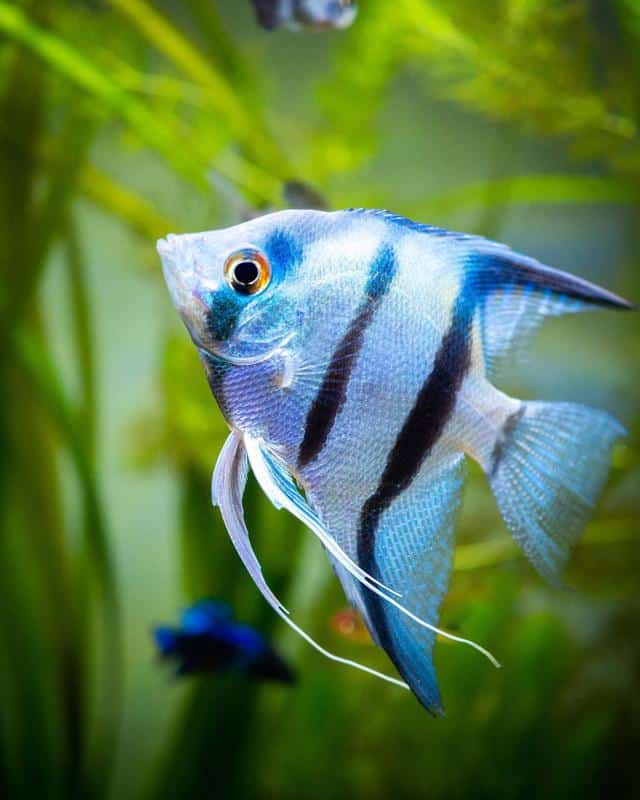
Zebra angelfish, as the name suggests, are recognized for their bold and striking zebra-like stripes that adorn their bodies.
They look somewhat like the silver angelfish – where they differ is in the number of stripes. Whereas the silver angelfish have three lines throughout their bodies, the zebra angelfish can have more, often ranging from four to six spread from their head to tail.
This type of angelfish usually comes from the Pterophyllum Leopoldi species, so they tend to be quite small.
7. Ghost Angelfish
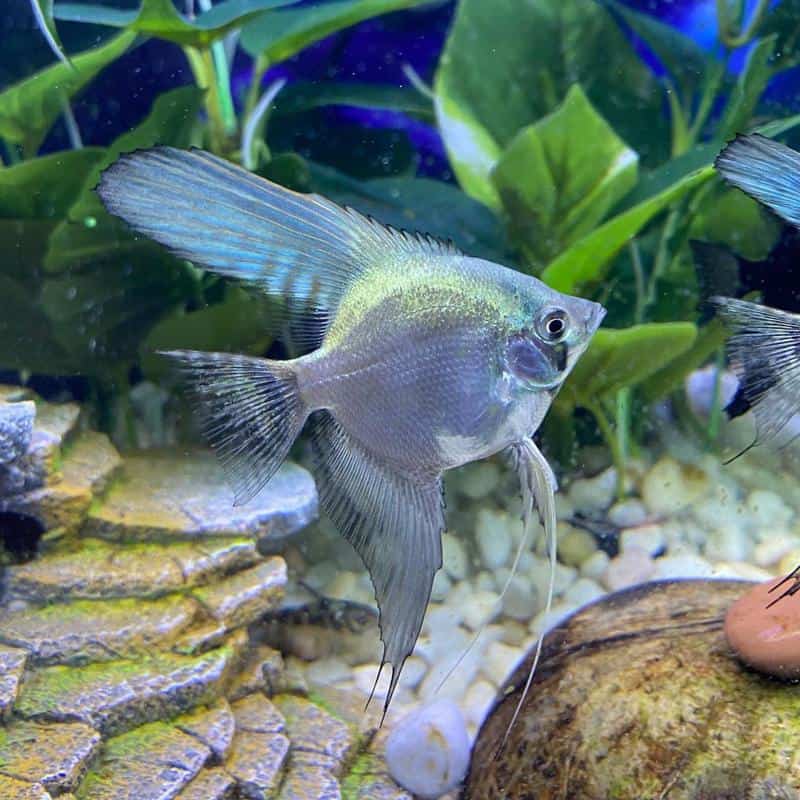
An angelfish is considered a “ghost” when they don’t have any stripes in their bodies and are instead composed of solid colors.
They can occur in any color base. However, the white or silver color base is considered the “platinum” variety, though technically, it’s a more specific category of the “ghost” angelfish. The most common color occurrences for ghost angelfish are black, gray, and blue.
The ghost angelfish can be particularly difficult to breed, making them highly prized by enthusiasts. This is because they can only come from two solid-colored parents.
Nevertheless, they don’t have any other special care requirements. If you can find them in your stores or from specific breeders, the ghost angelfish will be a delight in the right aquarium.
8. Pearlscale Angelfish
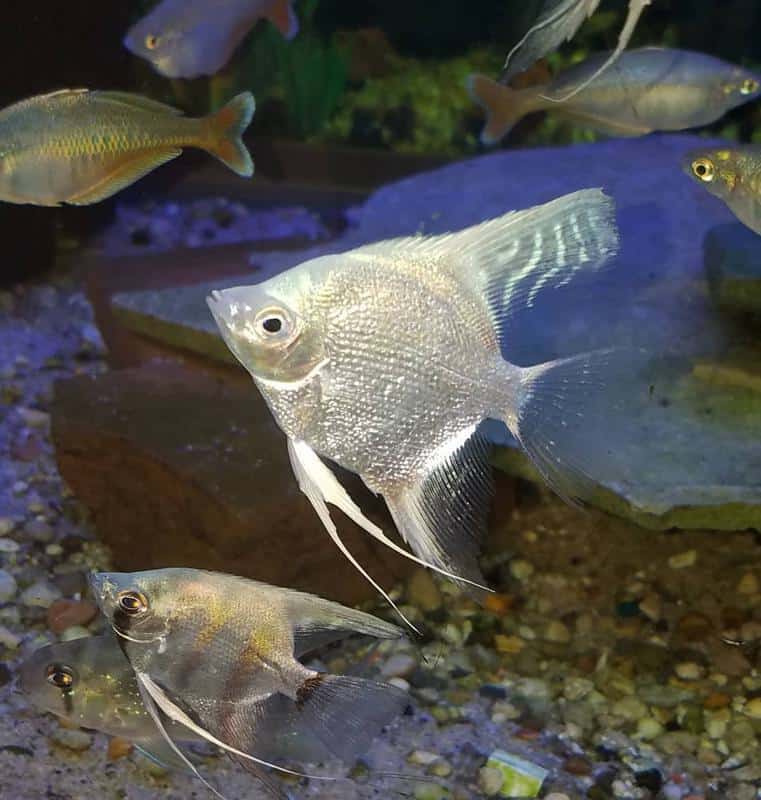
Just like the “veil” variety, the pearlscale type doesn’t describe color but instead describes other physical qualities. In this case, pearlscale refers to angelfish with remarkably textured or glittery scales.
They are particularly captivating because of how light reflects off of their individual scales, creating a shinier and more glittering effect than other types. Next to the sheen of the pearlscale angelfish, other variety’s scales look dull.
You can get pearlscale angelfish in many different colors, the most popular being the blue pearlscale, gold, and silver color varieties.
9. Platinum Angelfish
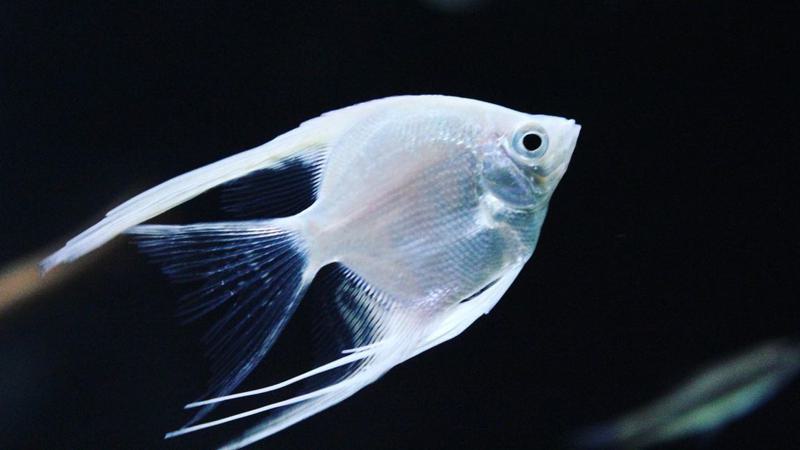
This variety is considered by many to be a vision of elegance, with their solid silvery white bodies that gleam in the water.
This variety contains no colorations in their body other than the pure white of their base color. A school of this pure white angelfish variety will make an indisputably fascinating and attention-grabbing tank, especially if you contrast them with a dark background.
More than that, they also tend to have a rounder shape with shorter fins than the other angelfish varieties, giving them a more compact look that doesn’t hamper their swimming.
10. Blushing Angelfish
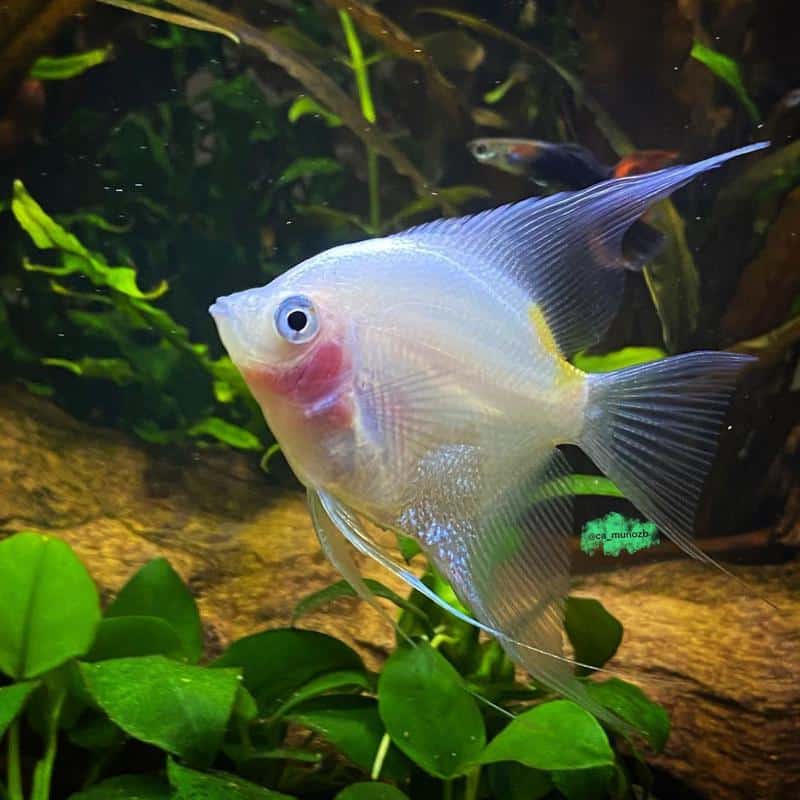
Blushing angelfish variety features a subtle blush of pink or peach on their cheeks and gill covers, adding a delicate and unique charm to their appearance.
They’re almost like the platinum variety if not for this spot of color. Depending on the parents’s genes, the color can range from pink to vivid red.
Care for these angelfish aligns closely with that of common angelfish, necessitating stable water conditions and a roomy tank to ensure their well-being.
11. Half-Black Angelfish
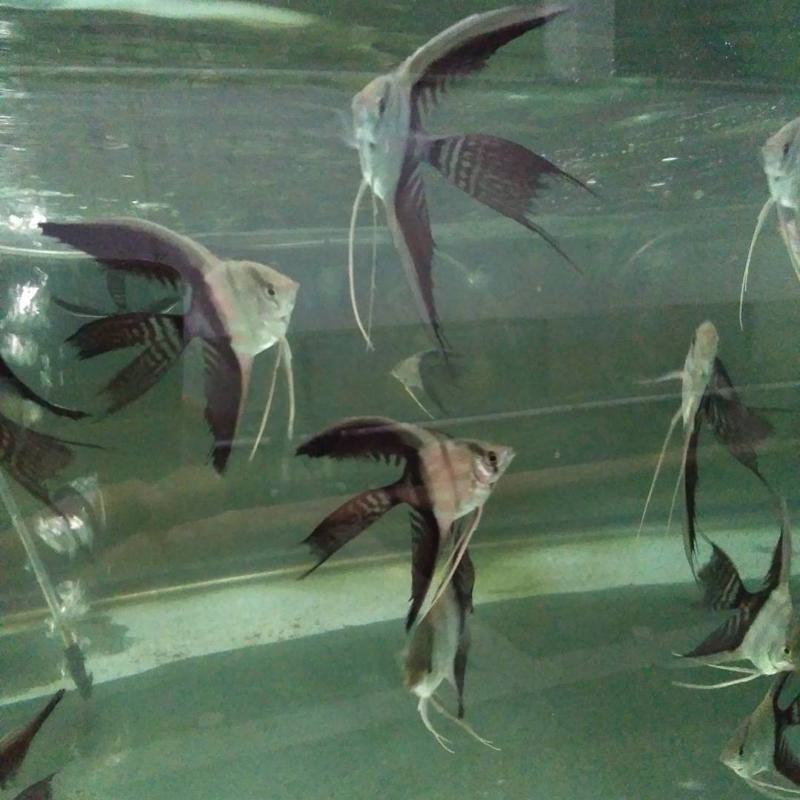
Also called the smokey variety, the half-black has a particularly striking color division that sees its body divided into two primary colors: light and black.
The half-black angelfish can have a base color of white, blue, or a lighter black called “chocolate,” but it will uniformly have a solid black coloration on the latter half of its body, including its tail.
This creates a captivating aesthetic quality that makes onlookers want to look closer at your specimen.
12. Golden Angelfish
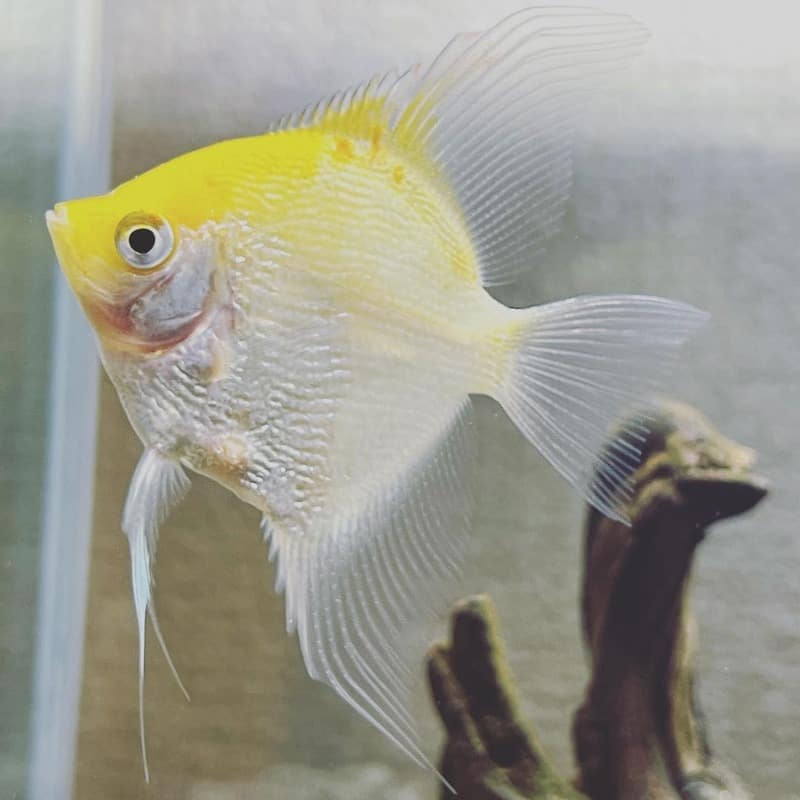
Gold angelfish are celebrated for their radiant golden-yellow coloration that catches the eye in any aquarium.
This variety has a base color of white and varying degrees of golden yellow. Golden angelfish juveniles can start looking like platinum varieties but develop lustrous colors over time.
When seen with the shimmering scales, elegant fins, and the fascinating way they interact, golden angelfish indeed seem like living treasures in your aquarium.
An entire school of golden angelfish in your aquarium can really make it pop out, especially if you house them amidst a lush green forest.
13. Clown Angelfish
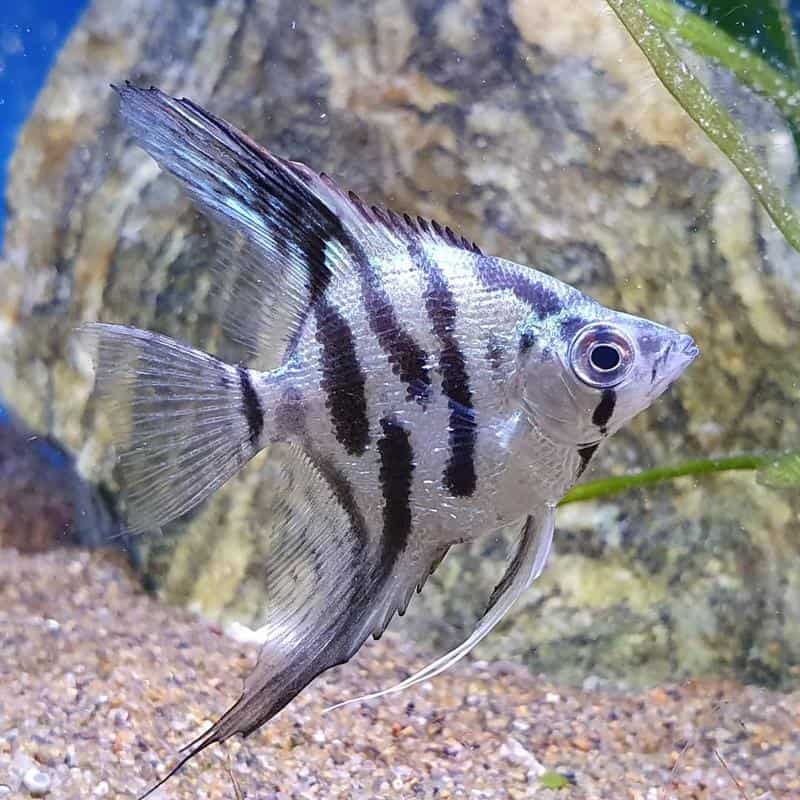
Reminiscent of the iconic clownfish, the clown angelfish features color patterns depicting large black spots across their bodies.
It’s important to note that it’s not the color of the angelfish that earns them this distinction, but rather the patterning and appearance of their dark spots. This fascinating coloration usually occurs on a base layer of silver, although some grow a blue sheen over time.
Clown angelfish is a particularly new variety to the hobby, so the demand is pretty high worldwide.
14. Chocolate Angelfish
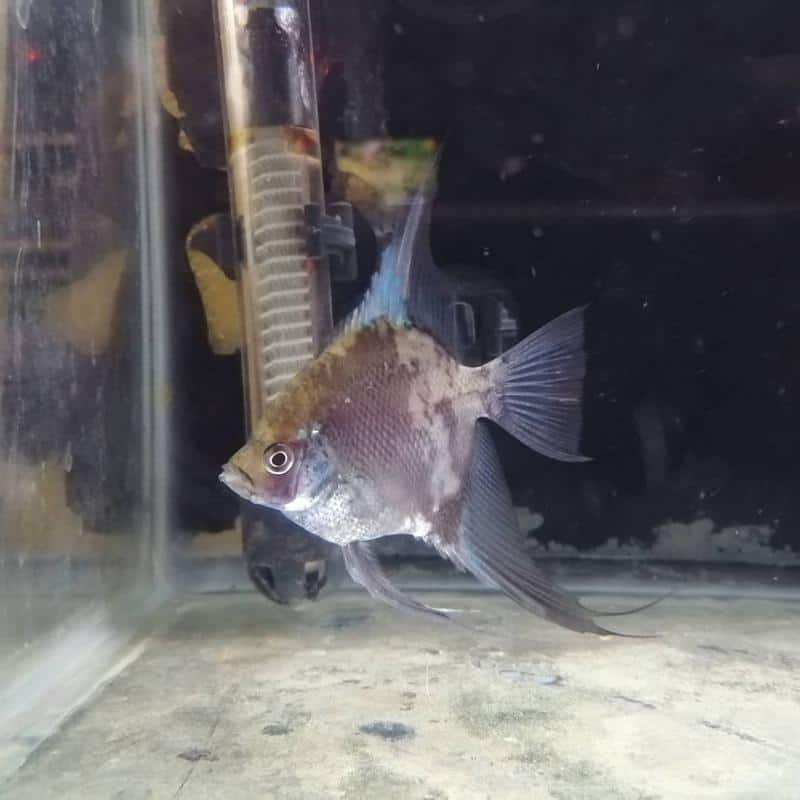
The chocolate angelfish is very distinctive because of their light black, almost brown-looking coloration, which looks much like chocolate.
There are many sub-varieties of the chocolate angelfish, with occurrences in blue, black, and white base colors.
Their rich coloration makes them particularly sought-after by hobbyists, although their variety is not that common, so you might need to put extra effort into finding some.
Nevertheless, they don’t have any special care requirements aside from baseline angelfish care.
15. Sunset Angelfish
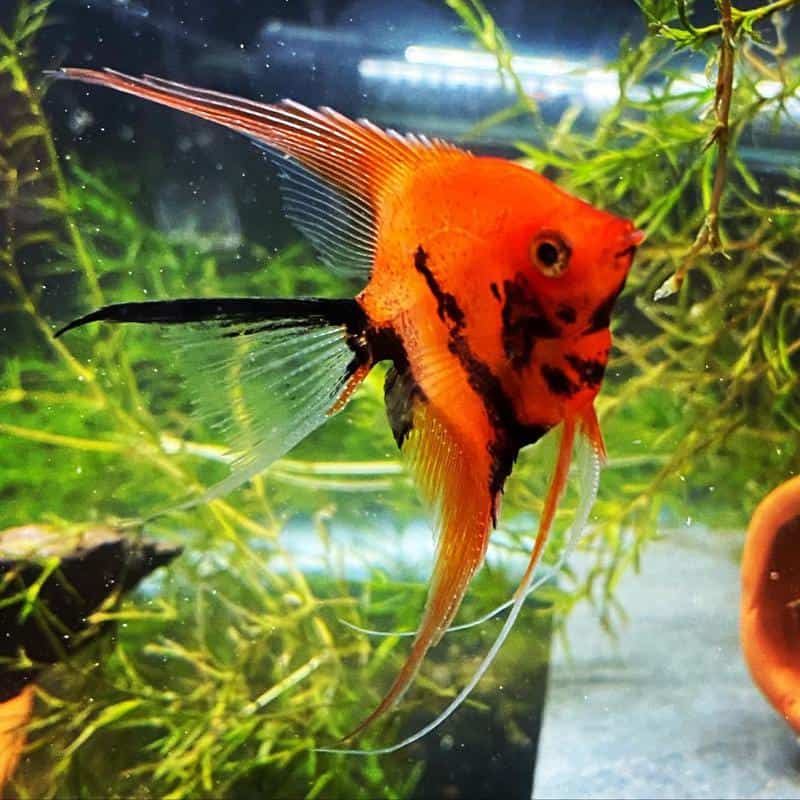
The sunset angelfish variety features breathtaking colors, composed of deep orange and white hues that would remind you of the sunset. Their colors occur in a gradient and are very sought-after because of the unique tranquility they add to any tank.
They are somewhat reminiscent of the koi variety, although they differ in that koi species have a predominantly white base color, speckled with orange or black.
The sunset angelfish, on the other hand, is composed of a deep orange color. It’s not an easy color to breed, so as of this writing, sunset angelfish are still pretty uncommon and can fetch a high price.
16. Blue Angelfish
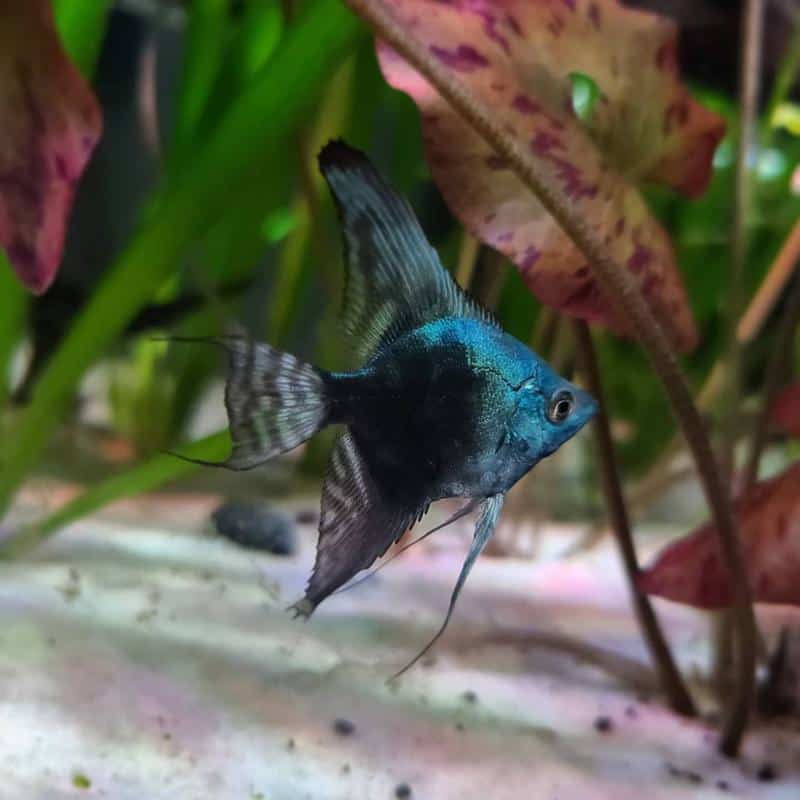
This variety is particularly rare and unique among angelfish types, making them very sought-after in the aquarium world.
Years of expert selective breeding have resulted in isolating the blue gene in some angelfish lines, resulting in something that would never have occurred in the wild.
The result is a fantastic-looking angelfish with magnificent blue scales. Their colors range from a simple blue sheen to deep blue coloration in their scales.
The powdery blue sheen even occurs overlaid on top of other colorations, such as the zebra, platinum, silver, and chocolate base varieties. Interestingly, one of the most popular is the Philippine blue angelfish, colloquially known as the Pinoy blue angel.
Read More:
FAQs
Are Angelfish Peaceful Fish?
Angelfish are generally peaceful and friendly but can be quite territorial, especially when a mating pair protects their eggs. But with enough space and proper consideration of tank mates, angelfish will generally leave other fish alone.
Are Angelfish Easy to Care For?
Angelfish are relatively hardy and adaptable, although they have more specific needs compared to other species. For example, their laterally elongated body needs a deeper swimming space. They are also cold-blooded tropical fish, so they can’t start overly warm temperatures.
What Is the Best Angelfish Variety?
The differences in angelfish variety are largely aesthetic, so the best one for you would be what you find the most beautiful. You can also consider the kind of tank setup and look you’re going for and pick the one most suited to the theme.
Conclusion
Angelfish is a wonderful tropical fish variety that can add a unique and distinctive look to any tank design, But with the popularity of the angelfish, different types abound. It’s no wonder that there are a ton of varieties.
That said, this can be overwhelming for many people who might not know what they want.
In this guide, we tackled the most common angelfish variety to help you along your aquarium decision-making. With your knowledge of the most popular freshwater angelfish, you now know what you want in your tank!
